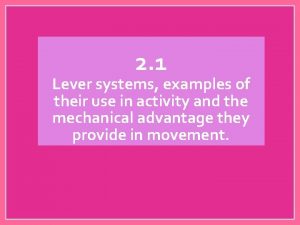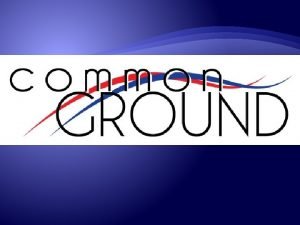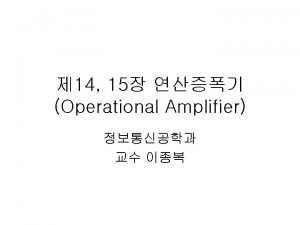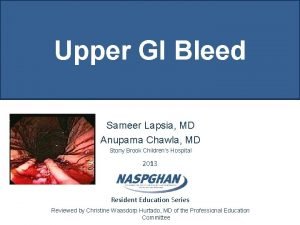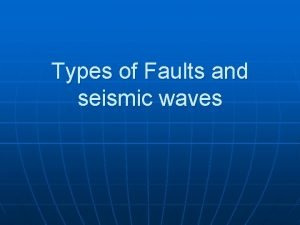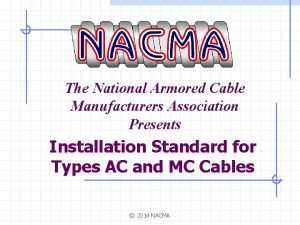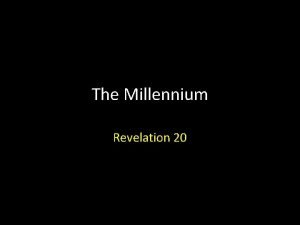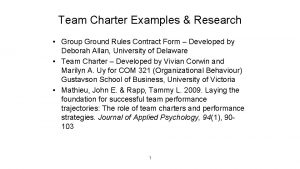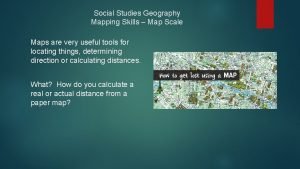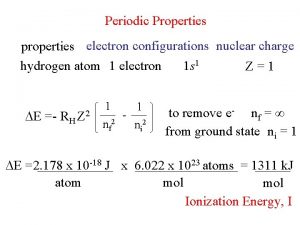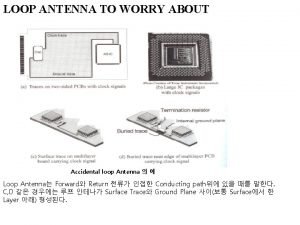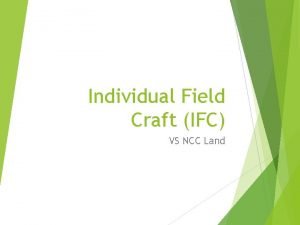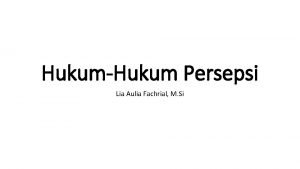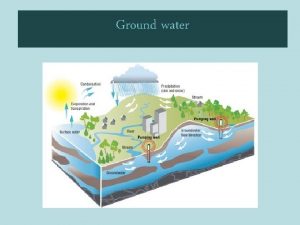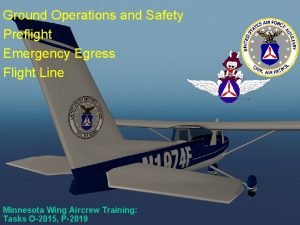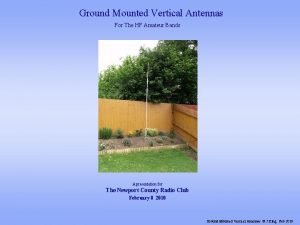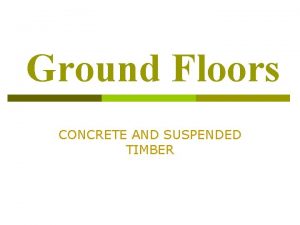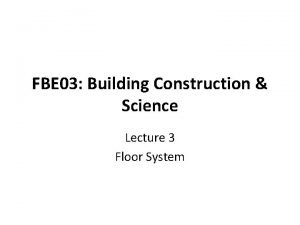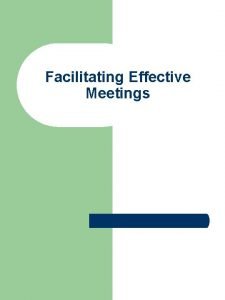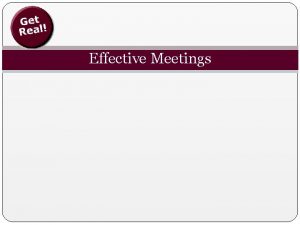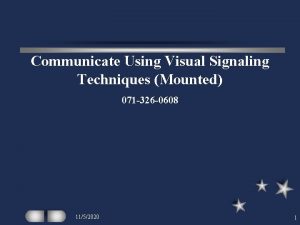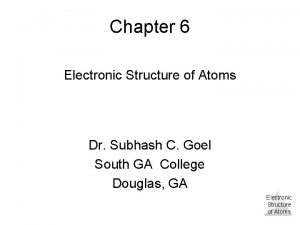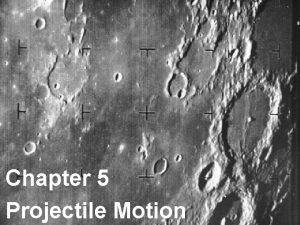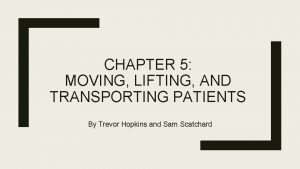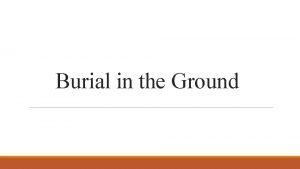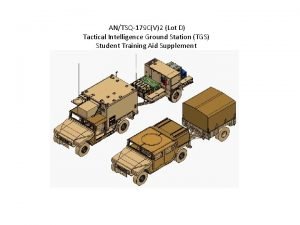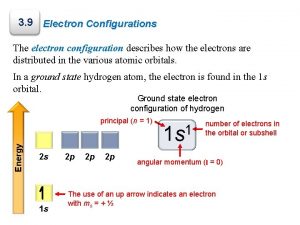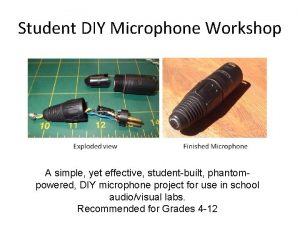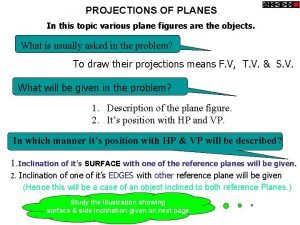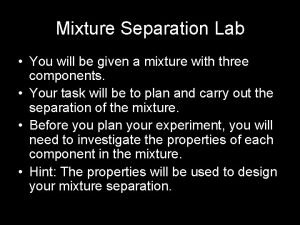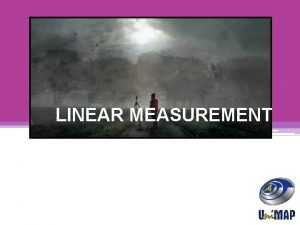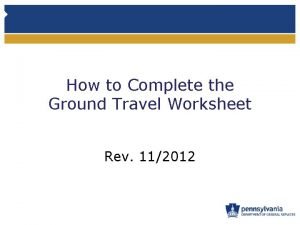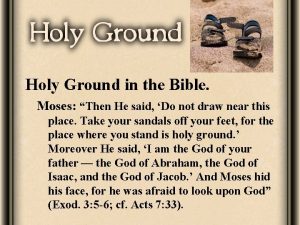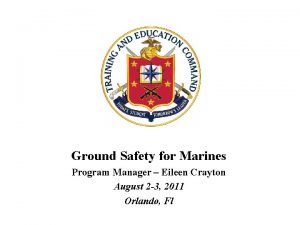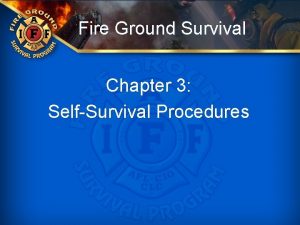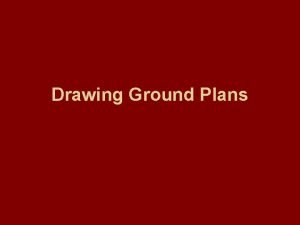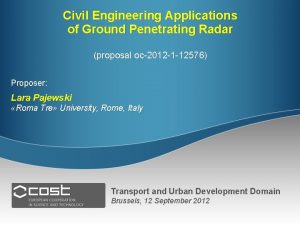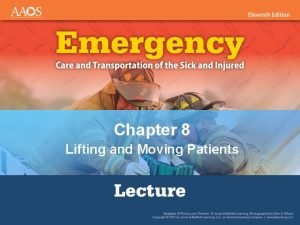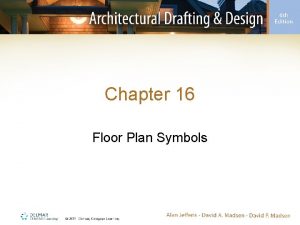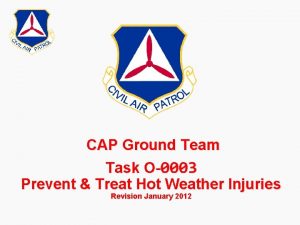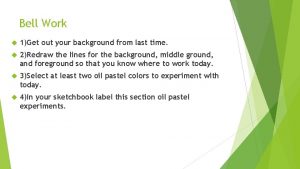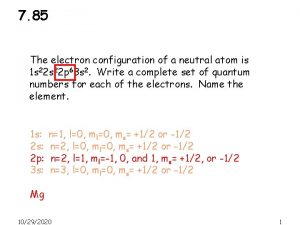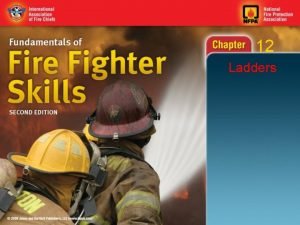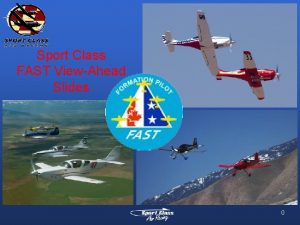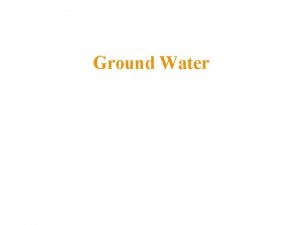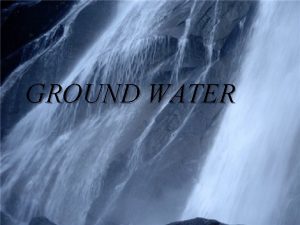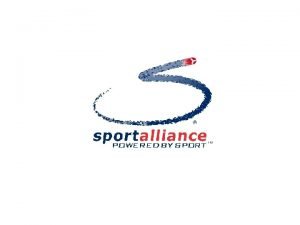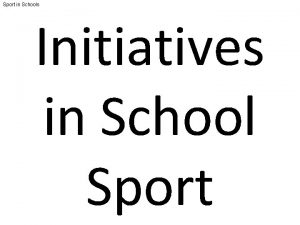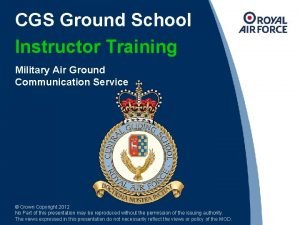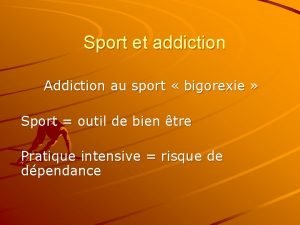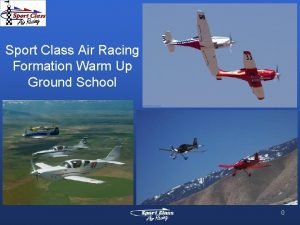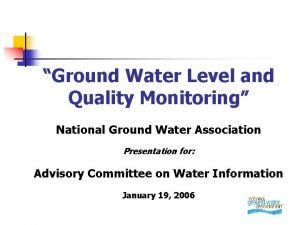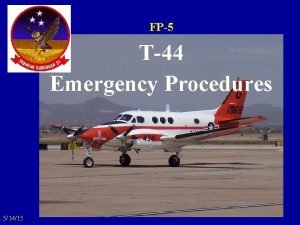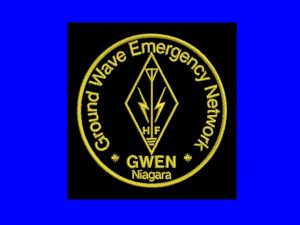Sport Class FAST Ground School 0 Sport Class



























































































- Slides: 91

Sport Class FAST Ground School 0

Sport Class Formation Ground School Overview • • • Part I: Part III: Part IV: Part V: Basic Positions Defined The Core Maneuvers & Procedures Pitchout and Rejoins Flying Extended Trail Safety

PART I BASIC CONCEPTS OF CLOSE FORMATION 2

The Formation Concept • • Challenging and Rewarding way to fly Based on Trust and Confidence Requires Discipline and Focus Know “The Contract” and Your Responsibilities

“The Formation Contract” • Flight Lead • • • Brief / Debrief Fly stable platform Control the flight maneuvers Monitor flight Terminate maneuvers if flight safety is compromised • Navigate • Communicate

“The Formation Contract” • Wingman • • Attend/understand briefing Always maintain visual contact Immediately advise lead if you do lose sight Don’t hit flight lead (or anyone else either) Follow briefed formations/positions Maintain listening watch Advise lead if traffic is observed Have exit plan ready

TAILORED TRAINING NOTE • Sport Class FAST Course is Tailored to Reno Air Race OPS • Training Charter: • Familiarization with FAST Procedures • View-ahead Brief • Specific Procedures To Support Racing 6

Formation Composition 2 -Ship • 2 -Ship = 1 Element • Basic building block • #1, Lead • #2, Wing • Proximity • Fingertip - Close • Route – More Space 7

The Bearing Line • Measured off of the nose of the lead aircraft • 45° for most aircraft • Bearing line deviation • Acute = forward of the bearing line • Sucked = aft of the bearing line 8

The Bearing Line Universal Sightline = Wingtip to Spinner 9

Fingertip: “Finger Four” 10

Formation Composition, 4 -Ship • 4 -Ship – (2 elements) • • #1 Lead #2 Wing #3 Deputy Lead #4 Wing 11

4 -Ship Configurations Fingertip Strong Left Fingertip Strong Right Close Trail Echelon Diamond 12

SCARA RULE ON CONFIGURATION CHANGES • Directed with Radio Calls • • Respond with Race Number Hand Signals / Aircraft Signals Exceptions = Pitchout Signal & Rejoin Signal Executed from Fingertip/Finger Four position • If in other than Fingertip: – – • Lead will regroup in Fingertip then move to a new configuration Lead may brief alternative for specific training events One exception is Moving to Extended Trail – – Pitchout from Echelon to Ext Trail is Standard Radio Call, 3 second interval, 4 calls in with separation » Must be well-briefed by Lead 13

PART II The Core Formation Events and Maneuvers 14

PART II - Format • Will discuss each maneuver in the normal flight sequence • Will cover • Position References • Radio Calls – Visual/Aircraft Signals for Pitchouts and Rejoins) • How to perform the maneuver • How Sport Class Tailors the procedures (where applicable) 15

Typical Training Profile • Interval Takeoff • Takeoff Rejoin • Route Formation • Fingertip Formation • Wing-work (station-keeping) • Cross-unders • Echelon turns • Pitch-out & Rejoins • Extended Trail • RTB • Recovery (overhead) 16

Flight Briefing • Critical to success of the flight • • Sets the tone for the whole flight Lead will use the Sport Class Briefing Checklist Brief the plan Listen Up / Ask Questions • No one mans up without clear picture of expectations • Fly the plan 17

Flight Briefing • • • Time Hack Establish Mission Objectives Weather & Environmentals Sequence of Events and standards to be used Mission Specifics • Details on how to achieve the training objectives. • Contingencies • Wrap Up & Final Questions 18

Briefing Highlight: Communications • Always brief a communication plan • Brief all frequencies if local flying • Initial check-in after engine start is generally on CTAF • During FAST Freq Plan is CTAF-Tactical-CTAF • During PRS Freq plan is GND – Race Control • Frequency change protocol • Use of “Go”: Acknowledge in sequence (“check out”) • Use of “Push”: Switch without acknowledgment • Lead will check flight in on new frequency in either case • Sport Class Standard for FAST and PRS – Always use “GO” 19

After Flight Brief Spot Aircraft Find tow driver—offer bribe Spot At least 20 Minutes prior to Take-off Lead Designates Spot and Start Times Meet for final brief at Lead’s airplane “No Prop Turn” line in effect Do not taxi or coast across it! 20

No Prop Turn Line 21

Engine Start • Be ready to start at briefed start time • Ensure area is clear of all but crew • Start when lead starts • If everyone in flight is turning, fire-it-up! • Brief Non-standard Start Requirements • Early Starts for Radials, etc 22

Check-in / Taxi • Pull forward 5 feet when ready to taxi • FAST - Check In on CTAF with Race Number • PRS – Check in on Ground Control • Taxi In Sequence • Spacing: • In trail: 4 Ship Lengths • Staggered: 2 Ship Lengths • Tail Dragger: Extend & Weave as required. BRIEF THIS! 23

• Run-Up Area Procedures “ 52 Ready” • • • Taxi into Pad in trail Angle to fit more aircraft in Run-up complete, check aircraft on both sides Last starts thumbs up moving forward Each aircraft passes thumbs up forward Pole or first wing calls ready to Lead/Pace 24

Run-up All Aircraft do Run-up on their own No run-up signal required Wingmen Pass Thumbs-up back to front First Wingman calls “XX Ready” to Lead switches flight to Race Control Frequency (“Go”) Do not auto switch to Race Control Check-In with Race number Lead announces Flight’s departure on CTAF Line-up and Launch using Sport Class procedures 25

Line-Up • First Wing taxis down runway to allow all members of the flight to stop on South (cold) side of the runway (new for 2016) • Angle 45 degrees to the runway heading • Lead follows flight onto runway • When Cleared for TO, Lead taxis past all aircraft • Racers give thumbs up to Lead/Pace • Lead/Pace Rolls and Calls 60 knots Revised March 2015

Interval Takeoff • Lead call 60 kts • Racers roll in order when previous racer is 1000 ft down the runway • Last Aircraft call airborne • Takeoff on Hot side, Abort to Cold side • • • Hot side is away from stands (N side) Cold side is turnoff side (S side, towards stands) Control the Aircraft Call the Abort Call Cold 27

Hot Side / Cold Side N S Revised March 2015

Rejoins After Interval Takeoff • Standard is a Turning Rejoin • Which side? • Tailored: ALL Rejoins in Sport Class FAST / PRS will be “Everyone Joins to the Outside of the Turn” Turn • Typical PRS/Race flight will be left rejoin turns • Join to right echelon • FAST hops will practice rejoins in both directions • Rejoins discussed in Part III of this Ground School 29

BREAK 30

Formation Station Keeping Universal Sightline = Wingtip to Spinner 31

Formation Station Keeping • • • Find “the bearing line” & stay on it Scan and maintain sightlines / visual references Wings level with lead Constant Corrections: – Stick: slight finger pressure – Throttle: “Controlled Aggression” Don’t fixate – develop a scan 1 2 • Primary reference provides “bearing” and “step down” • Secondary reference sets spacing 1 2 Example, RVs: RV Primary line of reference: Outboard aileron hinge on spinner Secondary reference: Tip of opposite elevator behind the rudder

Station Keeping 101 • Establish & Maintain your Sightlines • Make constant, small corrections • Relax the “Death Grip” & “Wiggle Your Toes” • Generally correct position in a logical sequence: • Correct to the bearing line • Correct vertical stack / stepdown • Correct lateral spacing • Eventually corrections are 3 D…but remember the basics 33

Station Keeping 101 • Recognition: Continuously and quickly correct back to THE LINE • Think: “small, timely corrections” • Anticipate, anticipate • Use trim to your advantage • Correct Hand Position on stick/throttle • Oh yeah…Relax, Relax…Breath! 34

Fingertip Turns • For the Wingman, relative altitude and radius of turn are changing when rolling into/out of turns • Pitch, Bank and Power changes occur • Maintain Parade Sight Picture • Welded Wing • Turns away from Wing: • Add power & increase pitch (climb) • Turns toward Wing: • Decrease power & decrease pitch (descend) 35

Route Formation 2 – 4 ship widths…to 500 feet “Abeam to no further aft than the bearing line” Trend Note: When sent to route, move out, not aft 36

Route Formation • WHY ROUTE? • • Checklists and “Ops Checks” Better lookout Long Cross Country flights to relax Holding airborne during airshows • Signal • Radio Call • Tail Wag or Fishtail (side to side) • Wing Pilots move out to maintain lateral separation. • 2 -4 ship widths for checklists and frequency changes 37

Flying Route • Turns • Wingman on the inside of the turn: • Fly route welded wing references • Wingman on the outside of the turn: • Fly echelon references to avoid large power req • (Stack Level in turn away) • Do not “creep” back to fingertip • Use good scan of lead when doing ops checks • To avoid unrecognized closure 38

Flying Route Keep your 2 -4 ship spacing until directed otherwise, and don’t slide aft… 39

Cross-Under • Used to move aircraft from one side of Lead to the other side • Set up flight for pitch out maneuver • Get Wingman out of sun • Give Wingman a change on cross country trip Sport Class Standard is RADIO CALL. 40

Cross-Under Execution Three part, primarily wings-level maneuver 1. Reduce power, move down and back • Add small amount of power to stop rearward movement 2. Change heading to move across to opposite side • • SLIGHT aileron/rudder pressure to create SLIGHT heading change NO LARGE BANK or YAW (should be imperceptible) Maintain nose to tail distance while crossing SLIGHT aileron/rudder pressure to re-align heading and stop cross 3. Add power, move forward & up into position 41

Cross-Under Execution 42

Cross Under DOWN and back Controlled move ACROSS UP and forward Avoid rounding the corners!

Echelon 44

Echelon • All aircraft on the same side of lead • Used for: • Pitch outs • Traffic pattern • Flying to the Chute 45

Turning In Echelon • Only turns away from wingmen in echelon • All aircraft pivot on longitudinal axis • Fuselage of Lead aircraft and aircraft ahead split the horizon • Do not unload in echelon 46

Line Abreast Formation • • • Flown in the Start Chute Will be practiced in the working area Flown on the 3/9 line (wingtip to wingtip) Lateral Spacing (in/out) is challenging Banking causes spacing difficulties Tendency is to roll where you look (so don’t!)

Ops Checks and Fuel Management • “Ops Check” • All in-flight checks performed in route formation • Check fuel, fuel balance and engine parameters • Report parameters as required. • Fuel State in minutes • Flight Lead radio call and acknowledgment: • “Sport 5 flight Ops Check”… “ 5: 55” • “ 22: 45” “ 2: 55” “ 39: 50” 48

Fuel Management • “Bingo” • Fuel state at which flight must terminate to return with legal minimums or as briefed by the Flight Lead • Day VFR: 30 Minutes Reserve • Generally briefed in ‘Time’ - fuel remaining in minutes in dissimilar aircraft formations • Example report: “Raven 3 is bingo plus 5” • Do not overfly briefed bingo! 49

Formation Recovery Overhead Traffic Pattern

Formation Recovery Overhead Traffic Pattern 51

Recovery Comms • Simplify Radio Calls for the overhead • VFR (GA) pattern aircraft are not familiar with overhead terminology • Race 22 Flight, 10 West, entering straight in overhead 8 • Race 22 Flight, 3 mile initial, runway 8 • Race 22 Flight, overhead, left break 8 • Race 22 Downwind Abeam • Race 22 Base / Gear • Race 22 Cold 52

Overhead Pattern Execution • Lead configures flight in echelon prior to Initial • Normal Radio calls alert wingmen to upcoming pitchout • Lead Signals pitchout and 5 sec interval (only hand signal we use) • Pitchout at 1000’ AGL (6000’ @ RTS) • Fixed Gear A/C - Level pitch to 6000’ DW • RG A/C - Pitch up to 6500’ DW • Sport Class Standard is 5 sec Interval for Landing Pattern • Creates 2000’ +/- interval on downwind • Interval about 90º ahead in approach turn • Know your interval and aircraft ahead of it 53

Landing Pattern Execution • Wing Pilots match aircraft ahead • Speed and configuration…aircraft type differences permitting • Coming Off the Perch • Continuous descending turn to final • Use same turn point off perch • Adjust turn point as needed for aircraft type (speed differential) • Do not descend early on downwind • Don’t chase lead down…forces entire pattern down • Keep interval(s) in sight • Adjust interval as needed with turn (lead/lag) • 90º behind aircraft ahead, 2000’ spacing +/54

Landing Pattern Hot-Cold Landing Procedure • Lead lands long on hot side (or centerline of runway if conditions warrant), then moves to cold side (ramp exit side) • • Each Wing Pilot does the same CONTROL YOUR CLOSURE ON INTERVAL BEFORE GOING COLD 2000’ +/- spacing at threshold <100 ft wide runway: No clear lane, increase interval • RWY 18 @ RTS • All aircraft roll to briefed exit to clear • No Early Turnoffs 55

Runway Exit Plan A 3 B NO EARLY TURNOFFS!

Recovery Notes Co-existing with Local Traffic • Simple, Clear Comms • Predictable, Consistent Overhead Entries and Patterns • Courtesy to slower and/or training aircraft • When in doubt of traffic interval • Ask for interval’s position • Fly-through (“spin it”) and re-enter, if needed • Heads up for variety of skill levels and experience • Student Training common 57

Taxi In/Shutdown • Lead assembles flight clear of runway, or • Individual Taxi OK – As briefed by lead • CAUTION entering ramp!! • Other Flights and their crew • Do not taxi or coast across No Prop Turn Line 58

Debrief • Lead Pilot directs the debrief • Wingmen get their shot when called • Critique all aspects of flight, as required • Examine the “what, why and how” of the sortie • Wingmen should not leave debrief with unanswered questions or concerns • Remember: Egos checked at the door • Goals: Safety, Mutual Support and Constant Improvement! 59

BREAK 60

PART III: Pitch-Out and Rejoin 61

The Formation Pitch-Out • Used to take spacing for • Rejoin practice • Extended Trail Maneuvering practice • Overhead Pattern for landing • Executed from echelon configuration 62

General Pitch-Out Execution • Signaled with RADIO CALL • Level, 60° bank, 2 G, 180° turn • 3 second interval • Match lead’s roll, G and flight path • “ 4’s IN” Call • For Rejoins: Last aircraft calls “in” when wings-level, directly behind preceding aircraft. • At completion of 180° turn (Differs from Extended Trail) • Rejoin Signal is Exaggerated Wingrock and radio call 63

Rejoin Techniques • Lead establishes a steady turn (20 -25 deg nominal) • Wingman turns inside to establish LEAD PURSUIT • “Rejoin line” = 45 deg – vertical stab on outside wing • Once on the rejoin line, modulate bank to fly up the line • Expect to DECREASE bank upon reaching “the line”. • Use angles, not throttle, to control closure (but manage airspeed) • If acute, DECREASE bank (giving you less lead/cutoff) • If sucked, INCREASE bank (giving you more lead/cutoff) • Stay LEVEL with lead – it’s an “in plane” maneuver • Lead ON Horizon to slightly above • Going low drives the entire flight low

Managing Your Closure • Bank angle controls your pursuit curve, and your pursuit curve changes your closure • Increase bank angle (or G) and pull lead pursuit = Increased Closure • Reduce bank angle (or G) and ease to lag pursuit = Decreased Closure • Airspeed control with Throttle as required • Try to minimize throttle use but manage speed 65

Overshoot/Under-run • Too much closure or very acute? • OVERSHOOT/UNDER-RUN • • • Decrease AOB and G Lower nose Reduce power Go below, behind and outside Stabilize Mover forward into position • No big plays to catch overshoot! • Never go belly up to lead! 66

Rejoin: In Trail

Rejoin: Establishing Cutoff

Rejoin: Proper Sight Picture

Rejoin: Acute

Rejoin: Sucked

Rejoin: Finish • • Fly Bearing Line until positioned to cross • 2 -3 ship-widths Cross smoothly to outside • Requires power as you move outside lead’s radius • No big plays to outside! • Ensure you have other wingmen in sight as you rejoin Too much closure or “smash” – Under-run! NEVER GO BELLY UP TO LEAD Ease AOB and g / Reduce Power Pass below and behind lead and entire flight Move up into position • No big plays back to inside! 72

PART IV Extended Trail • • Exercise to manage nose to tail with lead/lag • Use pursuit curves, not power to: • Control Nose to Tail • Control Closure • Manage Aspect • Fluid position • 500’ - 1000’ Nose to Tail • No closer than 200 feet or KIO/breakout Evaluated using wingovers, max bank angle 90 degrees Lead may brief and fly greater or lesser angles based on exp Operational Applications: • Rejoins and Landing Interval • Confidence Builder! 73

Entering (Separating to) Extended Trail • Entered from Echelon • • • Flight Lead Brief procedures in detail Use Voice call to initiate Standard 3 second pitchout “ 4’s In” Call • For Extended Trail: Last aircraft calls in when achieving the desired spacing and ready for maneuvering • Differs from PO/RJ in this respect • (no need to wait for 180° of turn) Lead maneuvers on “ 4’s In” call 74

Flying Extended Trail Lead Pure Lag 75

Rejoin from Extended Trail • Flight Lead flies S&L for short period • • • Large Wingrock Turn for rejoin Standard Rejoin Procedures 76

PART V SAFETY • • • Collision Avoidance Knock It Off May-Day Hard Deck Safety Equipment 77

Safety Collision Avoidance • • • Always keep lead in sight Always closely monitor relative motion and closure Always maintain separation Always consider prop wash and wake turbulence Never move ahead of your lead aircraft Never go “belly up” to your lead aircraft 78

Safety Calls • “Knock It Off” (KIO) • USE IT When a safety issue is developing • For immediate hazards to flight • Impending collision, etc. • In those cases, be directive first • Who can call a KIO? • What do you do if you hear it? 79

Safety Calls • “Knock It Off” • Anyone can call KIO • “Sport 5 Knock It Off, Altitude” • Lead will acknowledge the call and all flight members will mirror his/her call” • “ 22 Knock It Off”…“ 39 Knock It Off”, etc. • Clear your flight path and await lead’s instructions – do not stop flying formation! • Flight will ease maneuvering and increase spacing at KIO call 80

Safety Calls • “Mayday” • Engine Failure, Critical Systems Failure Structural Failure, Midair • After Mayday call - Lead will Knock It Off and take control • No echoed KIO call for a Mayday • Only essential comms • Clear your flight path and await lead’s instructions • Do not stop flying formation! • Flight will ease maneuvering / increase spacing at KIO call 81

Safety The Hard Deck • “Virtual” ground level • Minimum maneuvering altitude • Should be derived from current charts • High enough to allow reasonable chance of bailout or recovery from unusual attitude/aerobatic maneuver as applicable • Must be briefed on every formation mission • Call KIO if penetrated 82

Safety Divert Fields Beckwourth/Nervino 4900’ MSL 4600’ Runway 122. 8 Reno INTL 4415’ MSL 11000’ Runway 118. 7 Truckee 5901’ MSL 7000’ Runway 122. 8 Silver Springs 4265’ MSL 6000’ Runway 122. 9 Carson City 4705’ MSL 6100’ Runway 123. 0 Dayton Valley 4414’ MSL 5300’ Runway 122. 9 83

Aircraft / Safety Equipment Reminder • • Dual Controls Intercom system Ability to transmit from rear/right seat Fire Extinguisher • FOR PRS: • Helmet • Gloves • Nomex flight suit 84

WORKING AREAS Reno MOA Base 13, 000’ Area 4 7, 500 -9, 500 123. 45 Area 5 7, 500 -9, 500 123. 55 Area 3 7, 500 -9, 500 123. 35 Alternate Freqs Area 2 7, 500 -9, 500 123. 25 Area 1 7, 500 -9, 500 123. 15 “One click up” 123. 17 123. 27 123. 37 123. 47 123. 57

Departure Paths to Areas 4 5 Outbound to Areas Dir to 1, 2, 3 3 Right (E) side of 395 corridor to 4, 5 2 1

RTB PATHS FROM WORKING AREAS – RWY 8 4 5 Returning to Stead RWY 8 3 1, 2 Dir to 5 mile Initial 8 3, 4, 5 Right (W) side of 395 corridor to 5 mile Initial 8 2 1

RTB PATHS FROM WORKING AREAS – RWY 26 4 5 Returning to Stead RWY 26 3 1, 2, 4 Circle 5 north, then to 5 mile Initial 26 (don’t pinch S) 3, 4, 5 Dir to 5 mile Initial 26 (2 options for Area 4) 2 1 Reno Class C Base 7, 200’

KRTS Airport & Pattern Integration • Formation Taxiing • Give way when able • Formation Takeoffs • Hold for arrivals or departures • Time the line-up and departure • Formation Arrivals • • Delay entry into Initial Extend Upwind prior to Break “Spin-it” and circle N to re-enter Initial Go-around if necessary • Multiple go-around can get colorful! • Secrets to Success – Communication and Patience!

Questions? – Let’s Fly! 90
 Acid fast vs non acid fast
Acid fast vs non acid fast Example of acid-fast bacteria
Example of acid-fast bacteria The ground gives way
The ground gives way Linda carey
Linda carey 2nd class lever examples in sport
2nd class lever examples in sport Sport class air racing
Sport class air racing Japanese elementary uniform
Japanese elementary uniform Hollow ground chamfer
Hollow ground chamfer Common ground partnership
Common ground partnership Source of contamination
Source of contamination Opamp virtual ground
Opamp virtual ground Coffee ground emesis
Coffee ground emesis Unsymmetrical fault analysis in power system
Unsymmetrical fault analysis in power system Rayleigh wave
Rayleigh wave Metal clad cable installation
Metal clad cable installation There is no neutral ground in the universe
There is no neutral ground in the universe Dry cow candy
Dry cow candy Team charter ground rules examples
Team charter ground rules examples Coffee ground emesis
Coffee ground emesis Ground vs excited state
Ground vs excited state The ground beneath my feet is open wide meaning
The ground beneath my feet is open wide meaning Above ground stems
Above ground stems Map scale maker
Map scale maker Proscenium stage design
Proscenium stage design Functions of stem
Functions of stem 3 tissues of a plant
3 tissues of a plant Zeff of h-
Zeff of h- Part of stage in front of curtain
Part of stage in front of curtain Example of an ode poem
Example of an ode poem What conducts power and ground to the driver's side airbag
What conducts power and ground to the driver's side airbag What conducts power and ground to the driver's side airbag?
What conducts power and ground to the driver's side airbag? Fall of potential ground test
Fall of potential ground test In ground trash cans
In ground trash cans Ground water treatment process
Ground water treatment process How to measure curved line distance on a map
How to measure curved line distance on a map Ground loop antenna
Ground loop antenna Bevel in class 2 amalgam
Bevel in class 2 amalgam Types of ground ncc
Types of ground ncc Persepsi gambar
Persepsi gambar Ground rules in a classroom
Ground rules in a classroom Ground water
Ground water Ground tissue definition
Ground tissue definition Ground egress
Ground egress Vertical
Vertical Difference between dpc and dpm
Difference between dpc and dpm Ground continuity test
Ground continuity test Reversible figure ground relationship
Reversible figure ground relationship Figure ground ambiguity examples
Figure ground ambiguity examples Like thunder gonna shake the ground meaning
Like thunder gonna shake the ground meaning Ground glass appearance fibrous dysplasia
Ground glass appearance fibrous dysplasia Functional requirements of an upper floor slab
Functional requirements of an upper floor slab Ground rules for meetings
Ground rules for meetings Finding common ground
Finding common ground Orbital vs energy level
Orbital vs energy level Li ground state electron configuration
Li ground state electron configuration Meeting ground rules
Meeting ground rules The point on the ground directly above the focus
The point on the ground directly above the focus Gci ground control intercept
Gci ground control intercept Ground guide signals
Ground guide signals Training ground rules
Training ground rules Ground state electron configuration of arsenic
Ground state electron configuration of arsenic Ground state of arsenic
Ground state of arsenic Chapter 5 projectile motion
Chapter 5 projectile motion Fowler position
Fowler position Metal-rich rock mined from the ground
Metal-rich rock mined from the ground Burying meat in the ground
Burying meat in the ground Sulfur ground state electron configuration
Sulfur ground state electron configuration Mdas antenna
Mdas antenna Virtual ground concept
Virtual ground concept Common ground theory
Common ground theory What are electron configurations
What are electron configurations Peak ground acceleration
Peak ground acceleration An instrument that constantly records ground movements
An instrument that constantly records ground movements Diy ground microphone
Diy ground microphone A regular hexagonal lamina of side a
A regular hexagonal lamina of side a How do you separate sand and finely ground polystyrene foam
How do you separate sand and finely ground polystyrene foam Taping over uneven and sloping ground conclusion
Taping over uneven and sloping ground conclusion Pa ground travel worksheet
Pa ground travel worksheet Holy ground in the bible
Holy ground in the bible Ground safety for marines
Ground safety for marines Grab lives fire
Grab lives fire The water beckoned invitingly to the hot swimmers
The water beckoned invitingly to the hot swimmers Ground plan theatre definition
Ground plan theatre definition Ground plan theatre definition
Ground plan theatre definition Civil engineering applications of ground penetrating radar
Civil engineering applications of ground penetrating radar When performing the rapid extrication technique
When performing the rapid extrication technique Floor plan introduction
Floor plan introduction Middle ground death penalty
Middle ground death penalty Ground team task guide
Ground team task guide Background foreground middle ground
Background foreground middle ground Write the full ground state electron configuration of o+
Write the full ground state electron configuration of o+ Trussed beam ladder
Trussed beam ladder




